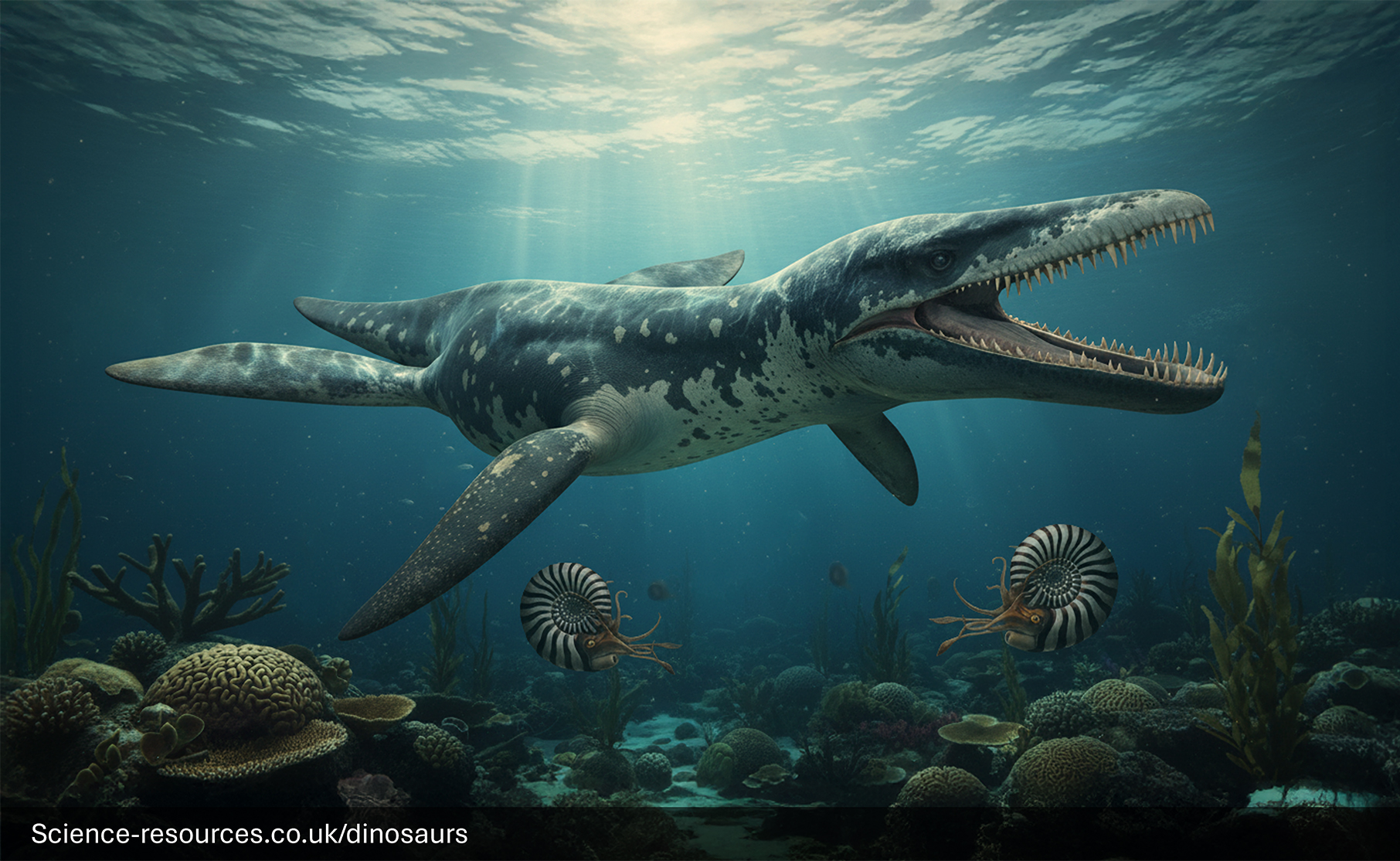Dinosaurs A:Z | L
You may also be intrested in: Free Dinosaur games
Dinosaurs and other prehistoric animals:
Liopleurodon (Smooth-sided Teeth)
You may also be intrested in: Free Dinosaur games
Liopleurodon was a marine reptile, not a dinosaur, that lived in the water during the Mesozoic Era. The name "Liopleurodon" means "smooth-sided teeth." This creature was part of a group known as pliosaurs, which were characterised by their short necks and elongated heads. Liopleurodon existed during the Late Jurassic period, approximately 160 million years ago. Fossils of Liopleurodon have been discovered in various parts of Europe, including England and France. Length: Liopleurodon was about 6 metres (20 feet) long, though some estimates suggest they could grow larger, up to 10 metres (33 feet). It had a powerful, streamlined body and short neck. Liopleurodon had a distinctive appearance with a large head, strong jaws, and sharp teeth. It had four large, paddle-like fins that helped it navigate through the water. Its body was muscular and robust, designed for efficient swimming and hunting. Generative AI Notification: Some elements of this image have been created or enhanced using AI technology. To find out how we create all our dinosaurs, click here. Liopleurodon was a carnivore, meaning it ate meat. It likely fed on fish and other marine reptiles. With its strong jaws and large teeth, Liopleurodon was capable of catching and devouring large prey. Liopleurodon hunting for ammonites Liopleurodon lived in marine environments. Fossils indicate that they inhabited shallow seas where they could find abundant food. They were adapted to life in the water, using their fins to propel themselves through the ocean.
What is an Liopleurodon?
When and Where Liopleurodon Lived
How Big Was Liopleurodon?
Appearance
 Liopleurodon
LiopleurodonWhat did Liopleurodon eat?

Where Did Liopleurodon Live?
Interesting Facts
Pronounced: Lie-oh-ploo-ro-don Name Means: "Smooth-sided Teeth"


Liopleurodon Facts
Length: 6 metres (20 feet)
Diet: Carnivore (Fish, Squid, Marine reptiles)
Time: Late Jurassic (160 million years ago)
Habitat: Open Seas
Fossils Found: Europe
Liopleurodon belonged to the pliosaurs, a subgroup of the plesiosaurs. Pliosaurs were known for their short necks, large heads, and powerful bodies, making them formidable hunters in the marine environment.
Liopleurodon was an excellent swimmer. It moved through the water by flapping its large fins, using a style of underwater "flight." Its streamlined body and strong muscles helped it to maneuver quickly and catch prey efficiently.
Liopleurodon had several unique features that set it apart from other marine reptiles:
Q1: What is Liopleurodon?
A1: Liopleurodon is a genus of large, carnivorous marine reptiles known as pliosaurs. They lived during the Middle to Late Jurassic period, around 166 to 155 million years ago.
Q2: How big was Liopleurodon?
A2: Liopleurodon could grow up to 10 metres (33 feet) in length, although some estimates suggest it might have reached up to 15 metres (49 feet).
Q3: What did Liopleurodon eat?
A3: Liopleurodon was a carnivore, feeding on fish, cephalopods, and other marine reptiles. It was an ambush predator, using its powerful jaws to catch prey.
Q4: Where have Liopleurodon fossils been found?
A4: Fossils of Liopleurodon have been discovered in Europe, particularly in England, France, and Germany.
Q5: Did Liopleurodon have any special features?
A5: Yes, Liopleurodon had a long, flat head with smooth-sided teeth, and four paddle-like flippers that helped it swim efficiently.
Q6: How did Liopleurodon move?
A6: Liopleurodon used its large flippers to propel itself through the water. It was well-adapted to a marine lifestyle, with a streamlined body for efficient swimming.
Q7: What is the significance of Liopleurodon in paleontology?
A7: Liopleurodon is significant because it provides insights into the evolution and diversity of marine reptiles, especially pliosaurs. Its fossils help scientists understand the adaptations that allowed these reptiles to thrive in ancient oceans.
Q8: Did Liopleurodon have any predators?
A8: As one of the largest marine reptiles of its time, Liopleurodon likely had few natural predators. However, it may have faced competition from other large marine reptiles.
Q9: How do scientists study Liopleurodon fossils?
A9: Scientists study Liopleurodon fossils using various techniques, including CT scans to examine bone structure and computer modeling to understand its swimming mechanics and behaviour.
Q10: What have recent studies revealed about Liopleurodon?
A10: Recent studies have provided insights into the feeding habits and physical adaptations of Liopleurodon, suggesting it was a highly efficient predator with a powerful bite.
Which family of marine reptiles did Liopleurodon belong to?
How Did Liopleurodon Move?
What Were the Unique Features of Liopleurodon?
Liopleurodon FAQ
You may also be intrested in:
Tags: How big was Liopleurodon, Liopleurodon size, where does Liopleurodon live, how long was Liopleurodon, what does Liopleurodon mean, Liopleurodon, Liopleurodon facts